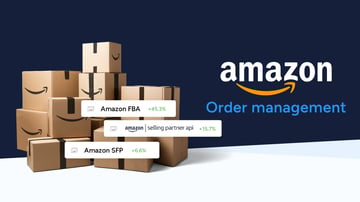Key Takeaways 💡
- Peak season is bigger than ever, with $6.09 trillion in ecommerce sales in 2024 and AI-assisted shopping shaping nearly 1 in 5 holiday purchases.
- Start planning 3–6 months ahead: build campaign calendars, forecast demand, and prepare fulfillment and returns strategies early.
- Content, pricing, and promotions must be mobile-first, competitive, and targeted to the SKUs that drive most revenue.
- Forecasting and inventory readiness are critical: scenario planning, dynamic allocation, and secondary suppliers prevent stockouts.
- Fulfillment and service discipline keep trust high—on-time delivery and proactive support protect performance and visibility.
- Peak season success isn’t just Q4: post-holiday tactics like bundles, loyalty, and remarketing extend momentum into the new year.
It’s never too early to plan for peak season. In just a few weeks at the end of the year, shoppers pour billions into Black Friday, Cyber Week, and Christmas. For brands and marketplace sellers, these few weeks can make or break the year.
Customers now expect more than discounts: they want fast fulfillment, seamless experiences, and hassle-free returns. For sellers, that means mastering promotions across multiple channels, avoiding stockouts, and keeping operations smooth under pressure. Preparation and flawless execution are what separate winners from the rest.
How big is peak season?
In 2024, global ecommerce sales reached approximately $6.09 trillion, marking an 8.4% increase from the previous year. November and December remained the dominant months for online retail, driving record-breaking volumes during Black Friday, Cyber Monday, Singles Day, and the Christmas rush. Consumers started shopping earlier than ever, with many deals going live weeks before the traditional Peak Season dates, fueling sustained growth throughout Q4.
Social commerce also gained major ground, now driving 20% of global online sales, with TikTok Shop and Instagram shaping discovery and conversion for younger shoppers. At the same time, AI-assisted shopping exploded – 19% of holiday purchases were influenced by AI, up 1,300% from 2023. Cyber Monday alone saw AI-bot traffic surge nearly 2,000%.
Another standout trend from 2024 was the surge in AI-assisted shopping. Holiday sales influenced by AI agents grew by 1,300% compared to 2023, with Cyber Monday alone seeing a 1,950% rise in AI-bot traffic. In total, 19% of holiday purchases were shaped by AI, highlighting the need for brands to optimize product data and listings for machine readability as much as for human shoppers.
With ecommerce growth accelerating and shopper behavior evolving rapidly, preparation is more critical than ever. Brands that integrate mobile-first experiences, flexible payment methods like Buy Now Pay Later, and clear marketplace strategies will be best positioned to capture peak season demand in 2025.
When should you start preparing for peak season?
The short answer: much earlier than you think. Peak season is a stress test for your entire business — from promotions and pricing to fulfillment and returns. Brands that only “switch on” in November risk margin erosion and missed sales.
A smarter approach is to reflect on the last peak season. What went smoothly? Where did operations break down? Whether it was misforecasted demand, campaign fatigue, or bottlenecks in returns processing, diagnosing those issues now gives you the best chance to fix them before the next holiday rush.
Ideally, allocate 3–6 months for preparation. That includes analyzing data to forecast demand, building campaign calendars, aligning budgets to the right channels, and creating segmented journeys that cut through inbox and social noise. It’s not about discounting everything—compelling bundles, smart offers, and clear messaging protect margins while still driving volume.
Peak season strategies: A ChannelEngine x Target Plus Guide
We’ve built this guide side by side with our partners at Target Plus, combining ChannelEngine’s operational expertise with Target’s marketplace perspective. Here’s a quick snapshot from Target Plus’s Path to Winning This Holiday framework:

1. Storytelling & content strategy
Content is one of the most powerful levers for peak season performance. Well-structured attributes, compelling visuals, and festive product copy help listings stand out in crowded marketplaces and reduce returns caused by unclear descriptions.
Mobile-first optimization is critical, with 70%+ of Q4 traffic coming from smartphones. Shorten titles, optimize visuals, and use concise bullet points that communicate value quickly. At the same time, prioritize updating the top 20% of SKUs that drive 80% of revenue. Localizing content for regional events like Singles Day or Christmas further improves discoverability and conversion.
2. Promo planning & pricing
Promo execution is more complex on marketplaces than in D2C, as discounts need to do more than cut prices—they must build trust and drive confident purchases. Shoppers expect value, and brands that can price competitively while still protecting margins are best positioned to win.
Instead of blanket discounting, focus on products with elastic demand (where a modest cut drives disproportionate volume) and safeguard inelastic SKUs with automation. Using a dynamic repricer, you can automate adjustments based on competitor moves, marketplace rules, and margin floors.
3. Drive the right demand
Driving demand during Q4 requires more than listing products; you need to be present where shoppers are already looking. Strategic media planning, campaign calendars, and retail media investments ensure your products stay visible at the right time.
Opting into marketplace-initiated promotions (like Target-run holiday campaigns) can amplify reach and boost conversion. Focus budgets on your selling SKUs. Layering in sponsored placements, retargeting, and social integrations can further help you capture attention and convert demand at scale.
4. Inventory forecasting & returns management
Forecasting requires more than reviewing last year’s numbers. Brands need to layer in external signals such as competitor sell-through, campaign calendars, and broader market trends to make accurate demand projections. Holiday returns are inevitable due to gifting, wrong sizing, and impulse buying. The key is to track patterns early and respond in ways that protect both customer satisfaction and profit margins.
- Scenario planning: Build best/worst/expected case demand models and assign buffer stock.
- Shared inventory pools: Dynamically allocate stock between channels, minimizing overselling.
- Supplier diversification: Q4 exposes fragile supply chains—set contracts with secondary suppliers early.
- Monitor velocity per SKU during early November promotions and reallocate inventory dynamically to best-performing channels before Black Friday.
- Plan for returns: Extend return windows, track reasons, and automate low-value returns to ease service load.
- Reduce preventable returns: Use clear product content, post-purchase guides, and sizing tips to set the right expectations.
By combining accurate forecasting with smart returns management, brands can keep stock moving efficiently, protect margins, and maintain customer trust during the holiday rush.
5. Fulfillment readiness
Customers expect accuracy and reliability during the holidays, and marketplaces enforce strict performance standards. Diversifying carriers, leveraging marketplace fulfillment for fast-moving SKUs, and setting clear cutoff dates help manage demand. Mapping delivery lead times by region allows sellers to prioritize where express shipping options will drive the most value.
Order routing is another critical lever: automatically directing orders to the warehouse or 3PL best positioned to fulfill quickly and cost-effectively keeps promises accurate while controlling costs under peak pressure.
6. Service & support preparedness
Even the best-prepared brands can face unexpected challenges during peak season. Building resilience into your operations ensures you can respond quickly without losing focus on sales and service.
Leverage marketplace support teams and fulfillment partners to troubleshoot issues such as order delays, listing errors, or sudden inventory gaps. Tap into your technology providers’ expertise to fine-tune automations and reporting when volumes spike. Clear communication lines with partners keep operations running smoothly, even under pressure.
Stress testing is essential: run simulations in October with doubled order volumes to identify weak spots in fulfillment, service, and support processes before Q4 begins.
Peak season don'ts
❌ Don’t leave your planning to the last minute. Peak season is no longer just November–December, it’s now building across months like July.
❌ Don’t offer discounts only on large ticket items: A significant share of conversions comes from value-priced products, not just expensive bundles.
❌ Don’t serve the same ads over and over again: fresh creative keeps messaging engaging and prevents blindness during high-frequency flash events.
❌ Don’t experiment with new campaigns or channels during Q4. Leave new pilots for quieter times. Q4 should focus on executing proven channels and tactics; any testing can be funded with peak-season profits later.
❌ Don’t shift carriers or overhaul operational processes mid-season. Keep your logistics proven and consistent. Holiday shipping demands are unpredictable enough without introducing new variables.
Are you dreading one of these 5 peak season horrors? We’ve got you covered! Check out our post to learn how to avoid common pitfalls and keep your business running smoothly during the busiest sales period.
How multichannel integrators help during peak season
Ecommerce marketplace integration software isn’t just a great tool for growth: it acts as a centralized order and inventory management system for all your sales channels.
A platform like ChannelEngine connects to your WMS, ERP, webshops, marketplaces, and other digital channels you’re selling on. It shows up-to-date stock information and location, enabling you to keep track of inventory and avoid selling out during busy shopping periods.
By pulling all your sales information together, you can also make more accurate stock forecasts and inventory purchases. You also gain the flexibility of selling with a hybrid model on marketplaces, switching between 1P and 3P to adapt dynamically to demand.
Bonus tips: How to keep sales coming in after Peak Season
- Product bundles: ChannelEngine’s AI-powered bundling feature lets you create irresistible deals that focus on value rather than steep discounts.
- Loyalty programs: Nurture the new customers you gained in Q4 by offering double points or early-access deals in January, and keep reminding them of their rewards.
- Free gift thresholds: Clear slow-moving dead stock while boosting order value by offering a small add-on once shoppers cross a spend threshold.
- Remarketing campaigns: Target holiday buyers with personalized follow-ups: recommend complementary products, or highlight seasonal essentials for the new year.
Plan early, stay ahead
Peak season is the ultimate test of preparation. Brands that start early not only maximize sales during Q4, but also turn first-time shoppers into loyal customers. Careful planning ensures you deliver a smooth, reliable experience when it matters most, building trust that lasts well beyond the holidays.
Schedule a free consultation with our marketplace experts and discover how ChannelEngine can help you prepare, execute, and win during peak season.





